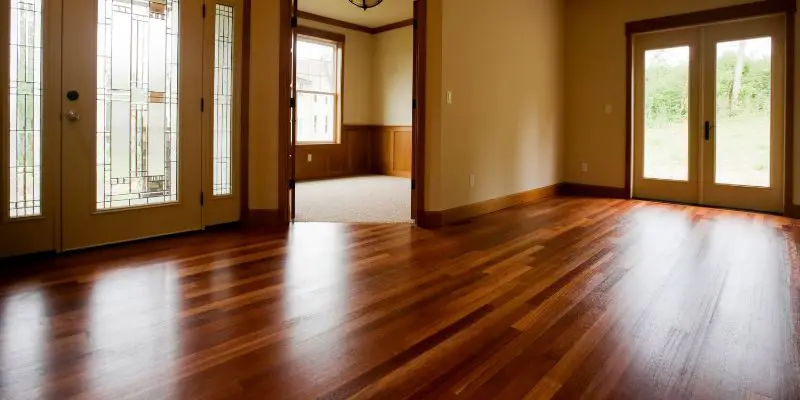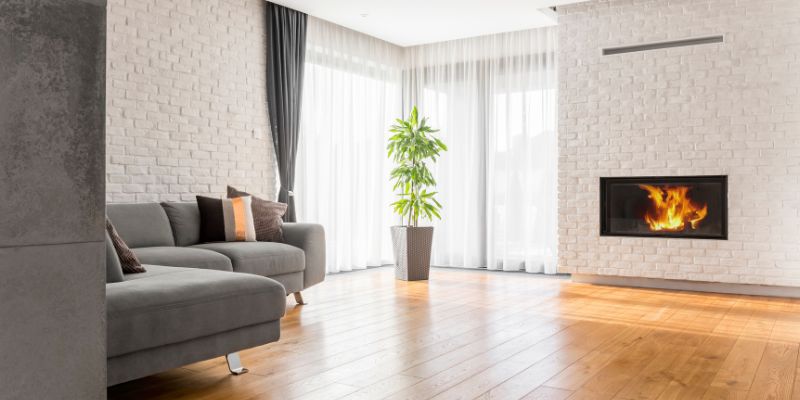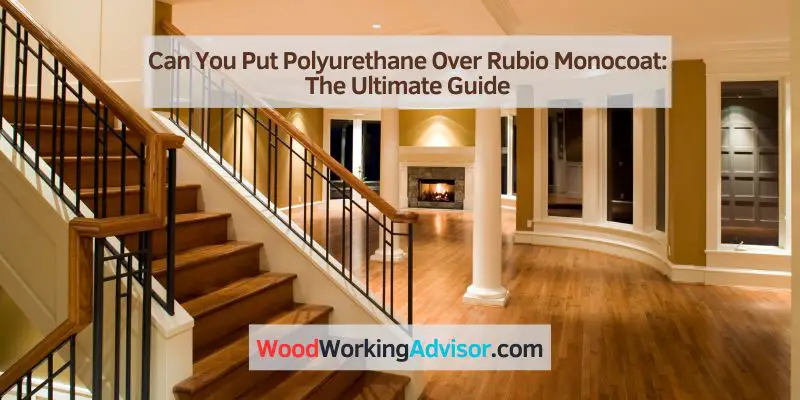Yes, you can apply polyurethane over Rubio Monocoat for added protection and durability. Polyurethane can be successfully applied over Rubio Monocoat to provide an extra layer of protection and durability to your wood surfaces.
Rubio Monocoat is an eco-friendly and easy-to-apply wood finish that offers great color depth. However, if you desire added gloss or protection, applying polyurethane can be a suitable option. This combination allows you to enjoy the benefits of both products – the unique coloration of Rubio Monocoat and the enhanced durability of polyurethane.
But before applying polyurethane, make sure to properly clean and prepare the surface, and follow the manufacturer’s instructions for best results.
Benefits And Drawbacks Of Polyurethane
Polyurethane is a popular option for finishing wood surfaces due to its durability and versatility. While there are several options available for wood finishes, polyurethane offers unique benefits and drawbacks that you should consider before making a decision. In this section, we will explore the advantages and disadvantages of using polyurethane as a finish for your Rubio Monocoat project.

Advantages Of Polyurethane
Polyurethane has gained popularity among woodworkers and DIY enthusiasts for good reason. Here are some of the key benefits:
Durability
Polyurethane provides a tough protective layer that can withstand everyday wear and tear. It creates a hard surface that is resistant to scratches, stains, and moisture, ensuring that your wood surface remains in excellent condition for years to come.
Wide Range of Finishes
One of the significant advantages of polyurethane is its versatility in terms of finishes. It is available in multiple options, including gloss, semi-gloss, and satin finishes. This allows you to choose the level of sheen that best suits your aesthetic preferences and the specific needs of your project.
Easy Application
Polyurethane is relatively easy to apply using a brush, roller, or sprayer. It dries quickly, enabling you to complete your project in a timely manner. Additionally, it can be easily recoated without the need for extensive surface preparation.
Protection against UV Rays
Polyurethane provides excellent protection against the damaging effects of ultraviolet (UV) rays. This means that your wood surface will be less likely to fade or discolor when exposed to sunlight, making it an ideal choice for outdoor applications.
Disadvantages Of Polyurethane
While polyurethane offers many advantages, it also has some drawbacks that should be taken into consideration:
Strong Odor
When applying polyurethane, it emits a strong odor that can be unpleasant and may require proper ventilation during the application process. It is essential to ensure that you work in a well-ventilated area to minimize any potential health risks associated with the fumes.
Yellowing Over Time
One of the downsides of polyurethane is that it has a tendency to yellow over time, especially when exposed to sunlight. This can affect the appearance of lighter wood surfaces and may require periodic maintenance to maintain the desired color.
Difficult to Repair
If the polyurethane on your wood surface gets damaged or starts to wear off, it can be challenging to repair. Unlike other finishes, such as Rubio Monocoat, which can be spot repaired, polyurethane often requires a complete refinish of the entire surface to restore its original appearance.
Considering the benefits and drawbacks of polyurethane will help you make an informed decision when deciding whether to use it as a finish for your Rubio Monocoat project. While it offers durability, versatility, and protection, it is crucial to be aware of the strong odor, potential yellowing, and the difficulty involved in repairing polyurethane finishes.
Advantages And Disadvantages Of Rubio Monocoat
Rubio Monocoat is a popular choice for finishing wood surfaces due to its unique characteristics and benefits. However, like any product, it also has its limitations. Understanding the advantages and disadvantages of Rubio Monocoat can help you make an informed decision when choosing a finish for your wood projects.
Benefits Of Rubio Monocoat
- Easy application: Rubio Monocoat offers a simplified application process. Unlike conventional polyurethane finishes that require multiple coats and extensive preparation, Rubio Monocoat only needs a single application for most projects. This saves you time and effort while still achieving excellent results.
- Natural appearance: One of the biggest advantages of Rubio Monocoat is its ability to enhance the natural beauty of wood. It penetrates deep into the fibers, bringing out the rich colors and unique grain patterns. The result is a beautiful, matte finish that showcases the wood’s natural allure.
- Durable and long-lasting: Rubio Monocoat provides exceptional protection for your wood surfaces. Once cured, it forms a strong molecular bond with the wood, creating a durable, waterproof barrier. This makes it resistant to scratches, wear, and common household spills. With proper care, Rubio Monocoat finishes can last for many years.
- Environmentally friendly: If you are concerned about the environmental impact of finishing products, Rubio Monocoat is a great choice. It is made from natural ingredients and contains no harmful chemicals or volatile organic compounds (VOCs). This means you can achieve a stunning finish while minimizing your ecological footprint.
- Repairability: Accidents happen, and wood surfaces can get damaged over time. The advantage of Rubio Monocoat is that it allows for spot repairs instead of having to refinish the entire surface. Whether you need to fix a scratch or refresh the finish, Rubio Monocoat enables you to address specific areas without much hassle.
Limitations Of Rubio Monocoat
- Limited color options: While Rubio Monocoat offers a range of colors, the variety is not as extensive as what you might find with other finishing products. If you have a specific color in mind, it is essential to check if it is available in the Rubio Monocoat line.
- Not suitable for high-traffic areas: Rubio Monocoat is durable and resistant to many types of wear, but it may not hold up as well in high-traffic areas like floors. Heavy use and frequent foot traffic can cause the finish to wear off more quickly, requiring more frequent touch-ups or reapplication.
- Requires proper surface preparation: While the application process for Rubio Monocoat is straightforward, it is crucial to prepare the wood surface properly beforehand. This includes sanding and cleaning the wood to ensure optimal adhesion. Skipping this step may result in an uneven finish or poor durability.
- Longer curing time: Unlike some quick-drying finishes, Rubio Monocoat requires a longer curing time. It can take up to 36 hours for the finish to fully cure, depending on environmental conditions. This means you will need to allow sufficient drying time before subjecting the wood to regular use.
- Can darken some woods: Rubio Monocoat reacts differently to different types of wood. While it enhances the natural color of most woods, it may darken certain varieties. If you have a light-colored wood that you want to keep as light as possible, it is essential to test the Rubio Monocoat on a small, inconspicuous area first.
Process And Considerations For Applying Polyurethane Over Rubio Monocoat
When it comes to finishing wood surfaces, Rubio Monocoat has established itself as a popular choice for its unique qualities. However, there may be instances where you might want to add an additional layer of protection or change the overall appearance of the wood. In such cases, applying polyurethane over Rubio Monocoat can be a suitable option.
Preparation Of Surface
Before you begin the process of applying polyurethane over Rubio Monocoat, proper surface preparation is crucial to ensure optimal adhesion and a smooth, consistent finish. Here are a few steps to follow:
- Clean the surface: Begin by thoroughly cleaning the wood surface using a mild detergent or wood cleaner. This will help remove any dirt, dust, or contaminants that could interfere with the adhesion of the polyurethane.
- Sand the surface: Use a fine-grit sandpaper to lightly sand the Rubio Monocoat finish. This step helps create a textured surface that allows the polyurethane to adhere effectively. Be careful not to sand too aggressively, as this could damage the underlying wood.
- Remove dust: After sanding, wipe down the surface with a clean and lint-free cloth or tack cloth to remove any sanding dust. Ensuring a dust-free surface is essential for achieving a smooth and flawless polyurethane finish.
Selection Of Polyurethane
Choosing the right type of polyurethane is crucial to ensure compatibility with Rubio Monocoat and achieve the desired results. There are a few key factors to consider:
- Type of polyurethane: Select a polyurethane that is compatible with Rubio Monocoat and is suitable for your desired finish. Water-based polyurethane is a popular choice due to its low odor, quick drying time, and easy cleanup. However, oil-based polyurethane offers a more durable and amber-toned finish.
- Finishing properties: Consider the level of sheen you want to achieve with the polyurethane. Polyurethanes are available in a range of sheen options, from high gloss to matte. Choose the one that complements your aesthetic preferences and the intended use of the wood surface.
Application Techniques
Applying polyurethane over Rubio Monocoat requires attention to detail and careful application. Follow these guidelines for a successful outcome:
- Even application: Using a high-quality brush or applicator, apply the polyurethane evenly across the wood surface. Work in thin and consistent coats to prevent drips, bubbles, or uneven drying.
- Drying time: Allow each coat of polyurethane to dry completely before applying the next one. Refer to the manufacturer’s instructions for the recommended drying time, as it may vary based on the specific product and environmental conditions.
- Sanding between coats: For a smooth and flawless finish, lightly sand the surface between each coat of polyurethane. This step helps promote adhesion and creates a smooth surface for subsequent coats.
By following these steps for surface preparation, selecting the right polyurethane, and employing proper application techniques, you can successfully apply polyurethane over Rubio Monocoat to achieve the desired finish and enhanced protection for your wood surfaces.

Alternative Finishing Options
When it comes to finishing and protecting your wooden surfaces, there is a wide range of options available. While Rubio Monocoat is a popular choice, you may be wondering if you can put polyurethane over it. In this article, we will explore alternative finishing options, including other compatible finishes and natural oil finishes.
Other Compatible Finishes
If you’re looking for an alternative to polyurethane, there are several other compatible finishes that you can consider. These finishes can provide a similar level of protection and enhance the beauty of your wood without compromising the durability.
One such option is varnish. Varnish is known for its impressive durability and resistance to wear and tear. It forms a tough protective layer on the wood surface and adds a glossy finish. Additionally, varnish provides excellent protection against water damage, UV rays, and scratches.
Another compatible finish is lacquer. Lacquer is a popular choice for its quick-drying properties and easy application. It forms a hard and durable coating on the wood surface, providing protection against moisture, heat, and chemicals. Lacquer also offers a beautiful, high-gloss finish that adds a touch of elegance to your wooden surfaces.
| Finish | Durability | Protection | Finish Type |
|---|---|---|---|
| Varnish | High | Water, UV, and scratch | Glossy |
| Lacquer | Medium to high | Moisture, heat, and chemical | High-gloss |
Exploring Natural Oil Finishes
If you prefer a more natural and eco-friendly approach, natural oil finishes can be an excellent choice. These finishes penetrate the wood fibers, nourishing and enhancing the natural beauty of the wood. Natural oils also provide a flexible and breathable protective layer that allows the wood to expand and contract with changes in humidity.
Tung oil is a popular natural oil finish known for its excellent durability and water resistance. It provides a warm, rich finish that enhances the natural grain of the wood. Tung oil is easy to apply and can be reapplied as needed to maintain the beauty and protection of your wooden surfaces.
Danish oil is another natural oil finish that offers great protection while maintaining the natural look and feel of the wood. It penetrates deeply into the wood, forming a protective layer that resists water, heat, and household chemicals. Danish oil also enhances the wood’s color and grain, leaving a smooth and satin-like finish.
Why Choose Natural Oil Finishes?
- Enhances natural beauty of the wood
- Allows wood to breathe
- Provides a flexible protective layer
- Easy to apply and reapply
- Resistant to water, heat, and chemicals
When it comes to finishing your wooden surfaces, the choices are abundant. Whether you opt for other compatible finishes like varnish and lacquer or explore the natural oil finishes like tung oil and Danish oil, you are sure to find a finish that suits your needs and enhances the longevity of your wood.
Frequently Asked Questions For Can You Put Polyurethane Over Rubio Monocoat
Can You Put A Top Coat On Rubio Monocoat?
Yes, you can apply a top coat on Rubio Monocoat to enhance its durability and protection.
Can You Put A Water Based Poly Over Rubio Monocoat?
Water based poly can be applied over Rubio Monocoat for added protection and durability.
What Are The Downsides Of Rubio Monocoat?
Rubio Monocoat has limited color options and may require frequent reapplication. It can also be more expensive than other wood finishing products.
Is Rubio Monocoat Better Than Polyurethane?
Rubio Monocoat is a great alternative to polyurethane due to its numerous benefits. Its single-coat application provides durable protection and enhances the natural beauty of wood. With its eco-friendly formula, easy maintenance, and extensive color options, Rubio Monocoat offers a superior finish for your wood surfaces.
Conclusion
Ultimately, the decision to apply polyurethane over Rubio Monocoat comes down to personal preference and the desired outcome for your wood surface. While both products offer their own unique benefits, it’s important to consider factors such as durability, maintenance, and overall aesthetics.
Whether you choose to enhance the natural beauty of your wood with Rubio Monocoat or add an extra layer of protection with polyurethane, be sure to follow proper application techniques for optimal results. Explore your options and make an informed decision that aligns with your specific needs and preferences.



One thought on “Can You Put Polyurethane Over Rubio Monocoat: The Ultimate Guide”